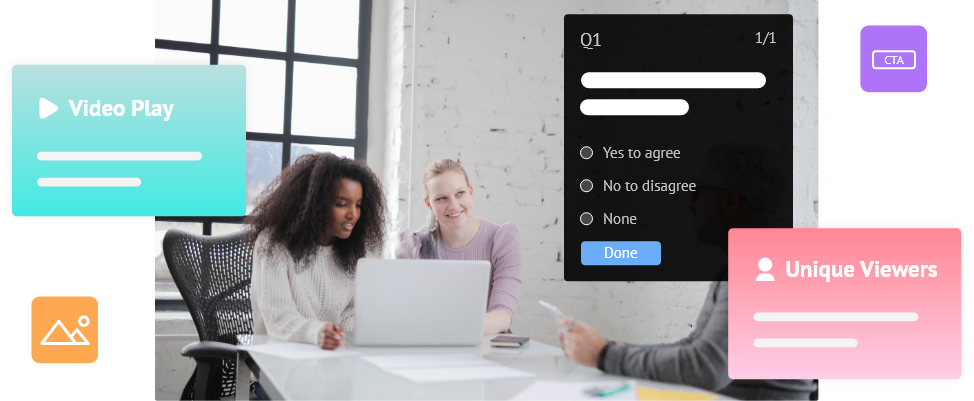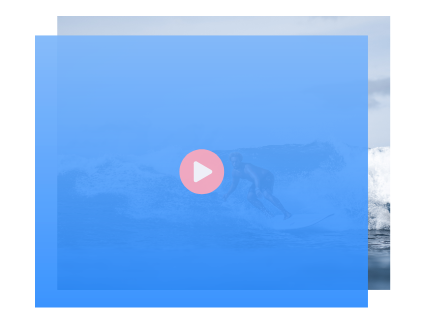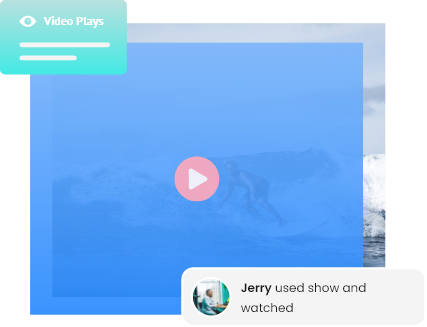


Over the past decades, the marketing world has evolved
dramatically.
Writing thousands of blogs and hoping for heavy traffic has now become
the past. Can you recollect your recent purchase of an item or
service?
Did you google it and start reading a blog post?
NOPE! You probably would have done what most people do nowadays.
You watched a video review on youtube or a product demo on Amazon.
We live in the era of videos. We are more inclined to wear what
influencers wear than what they ask us to wear. We live VISUALLY. It’s
a fundamental shift in the way we do business.It’s called
VFM - Video First Marketing.
The next-gen marketing strategy that leverages video to improve funnel conversions, increase revenue and customer retention.
It helps SMEs as well as enterprises deliver cross-functional (sales, marketing and communication) content across channels to drive business growth.
VFM is all about creating relevant and remarkable video content tailored for each stage of the buyer's Journey.
Simply put, you'll be helping them to understand their problems by providing the solution in an easily digestible content form that has the highest attention span.

VFM helps you take back control of your content. It is the most personalised and effective way to attract, engage and persuade your customers.

A few weeks into the pandemic, when all professional sports events were cancelled, Nike released a new video — Never Too Far Down. It was a simple montage of sportspeople in their lowest moments. Followed by their eventual comeback.
For a world locked in by a raging pandemic, it offered hope, meaning and purpose for perseverance. No article, no podcast, no book could have done what that 90-second video did: Move people, instantly.
The time when people ‘read’ a ‘blog’ and bought a product are long gone. Today, even among Google search results, people prefer video; so much so that Forrester Research once found that video is 50x more likely to rank on Google search than text. And our own stats at Animaker show that landing pages with videos have 15% less bounce rate than landing pages with only text and images.
This is what marketers need. They need the ability to attract, engage, persuade and move people. Being video first, helps you get there.
Video helps increase conversions by over 20%
Clickthrough no longer works as an effective measure of your campaign performance. Because, the average time spent on a landing page is abysmal — less than 15 seconds in most cases. This is why most marketers experience very low conversion rates, in spite of spending millions in advertising.
Video first marketing solves this problem. When you add a video on the landing page, visitors invariably play it, staying longer, knowing more about your product, signing up for a demo, and eventually turning into customers. A US-based Animaker customer increased their email open rates to 40% and their sales conversions by 20% by adding video to their communication stack.
Over 50% of your audience want more video (and 82% of social media marketers plan to create only videos in 2021).
HubSpot asked people, “in general, what content types do you want to see more of in the future?” and an overwhelming majority said video. 53% of the overall survey population and 65% of those in the 18-24 age group say that they prefer video over any other form of content — blogs, emails, podcasts included!
Video first marketing capitalises on this observation. By giving your audience more of what they want, you improve your chances of being heard. It’s only natural that 82% of the social media marketers Animaker spoke to say that they’re already going video first!
"Because viewers actively choose online videos, they tend to watch them more attentively than they watch TV ads"
Global attention span is falling. People skim or multitask while reading text or consuming audio forms. Video, on the other hand, is the only medium that ensures your audience attention completely. A study also shows that 48% of those who watched an online ad at any point subsequently visited the brand’s website, 11% shared the video with a friend, and 22% made a purchase.
While watching a video, customers stay on your page, listen to your message and watch your visuals with focus. This helps you engage them better and for longer, dramatically increasing your conversion rates.
Most importantly, video offers a superior, personal and authentic connection with the viewer.
Customers today don’t want to be lectured to. They want to see and hear stories. They want to be moved and inspired. They want to be reassured and persuaded. There is no better way than video to connect with your customers on a personal level.
Don’t believe us?
Here’s what research shows:
- 86% of video marketers say video has increased traffic to their website
- 94% of video marketers say video has helped increase user understanding of their product or service
- 84% of video marketers say video has helped them generate leads
- 78% of video marketers say video has directly helped their sales teams convert more opportunities into wins
If you are thinking ‘I’m already doing videos and it’s not working for me’, it’s because you’re not doing video first marketing. Here’s why.
Replacing text with video and calling it video marketing:
Most content marketers are writers. They think in articles or blog posts. They then convert those ideas meant for written content into videos and promote them.
Naturally, this doesn’t work because it’s not meant to be a video in the first place!
Not operationalising the video creation process:
Let’s accept it. Once the research and idea are in place, the logistics of creating a video is a lot more effort than writing an article.
Without the right tools, this can soon become tedious and the teams will give up.
Excessively relying on social channels for growth.
Creating videos for Youtube builds Youtube’s business, not yours! By approaching your video strategy as a way to post on YouTube or other social media, you are underestimating the potential of video.
Most businesses today are doing ‘video marketing’, not ‘Video First Marketing. And that makes a big difference.
The answer is in the marketing strategy!
Today, most marketing organisations are making videos and uploading them to YouTube as their distribution strategy. This is growing YouTube’s business, but how much value is it adding to yours?

You use existing videos to promote and market your product or service.
You fit yourself into platforms like YouTube, social media ads etc. to relay the content.
You want to increase quick engagement and educate your audience through a new medium.

Anchor your marketing strategy around video
You own the content first marketing platform
You will build long-term relationships with your customers using video


Your current marketing strategy leaves a lot of money on the table.
You need a change. You need a marketing strategy that attracts and engages everyone who visits your site or sees your communication elsewhere. You need a marketing strategy that is optimised for conversions, without burdening your sales teams.
Video First Marketing is exactly that.
Get the Business DONE today by connecting with few apps
59% of executives say that they always choose video over text on the same topic.
Video First Marketing accelerates your top of the funnel marketing and helps acquire customers faster in two ways: Organic (inbound) and paid (outbound).
Video First Marketing for organic acquisition: In a sea of written text on the search engine results page (SERP), videos stand out, bringing new visitors to your website. Once they’re on your site, strategic videos drive acquisition.
For example, instead of offering a newsletter subscription or sign up — especially at the wrong time, like when the user tries to close the window — you can use video to engage visitors in real-time, capture them as leads using a player-based lead form and convert them to customers.
Video First Marketing for paid/outbound acquisition: "Enjoyment of video advertising increases purchase intent by 97% and brand association by 139%," finds a study. This is true of all outbound acquisition channels — adding a video while cold-emailing prospects or advertising on third-party platforms. If you can personalise it, even better!
But remember, Video First Marketing works best when you use your videos on your own real estate, not on platforms like Facebook or Youtube.
45% of viewers watch a video all the way through, regardless of the video’s length. 58% watch till the end if it’s less than 60 seconds.

In the middle of the funnel, once you have got the customer’s attention, focus on personalised engagement — the operative word being ‘personalised’. A successful engagement strategy needs to identify: Right people, right video and the right time.
Here’s how you can do that with Video First Marketing.
Right people
Typically, customer engagement addresses two kinds of users:
Once you know who is who, the next step is to show them the right video.
Right video
The right video is short, concise and personalised. Your customer isn’t coming to your website to be entertained; they want to be educated on your product. (You must do it entertainingly, of course. But educating them quickly and clearly is paramount).
However, real engagement comes from personalisation. The right call-to-action nudges the prospect from their current step to the next.
Video First Marketing empowers you with knowledge about every customer, much more than text-based content can. This helps personalise their experience further, engaging them deeper and building a long-term relationship with them.
Right way
There are several ways to present videos to the prospect — embedded videos, popups, emails, even push notifications. Choosing the right time and sending the right way can be the difference between a sale and a sorry face.
Today, almost all technology is moving to a subscription model, which means you have to earn your revenue month on month. Video First Marketing can help automate retention by using videos for new feature announcements, refresh video for inactive users, ‘miss you’ emails before churn.
87% of sales professionals believe that video viewing data is important to qualify leads, engage prospects and influence specific deals.
In a traditional marketing campaign, qualified leads are those who show interest in our content and reach out to us. This process may take days, if not months, to materialise.
Video First Marketing can help generate Video Qualified Leads (VQLs) in minutes. Here’s how:
The prospect is not a passive viewer; neither should you be. Add quizzes or simple forms asking for email id, phone number etc., to understand the prospect further. Allow customers to book meetings right from within a video player while watching a pre-recorded webinar.
Integrate this information into your CRM, taking your Video First Marketing strategy towards organisational success.
84% of people say that they’ve been convinced to buy a product or service by watching a brand’s video.
Whether your conversions are sales-based or no-contact, Video First Marketing can help improve your bottom-of-the-funnel conversions effortlessly.
In a sales-based approach, Video First Marketing brings in personalised videos that address your prospects’ needs and expectations. Customised videos reduce sales effort and limit back-and-forth conversations involving multiple parties.
In a no-contact approach, Video First Marketing invokes automatic engagement. If a prospect is lingering on the pricing page for too long, you can trigger an automatic pop-up video to address their concerns. You could do this for in-app upgrades too, for instance.
People are twice as likely to share video content with their friends than any other type of content, including social media posts, blog posts/articles and product pages.
In a traditional marketing strategy, support to the potential customer is usually done with FAQs, chats, email exchanges, screen share and calls. The effectiveness of these methods is questionable, but one thing beyond doubt is that it’s resource-intensive.
Video First Marketing can help develop a video-based content strategy to operationalise and automate customer support. Some videos you must make are:
Go one step further and invite customers to create videos of their queries. You can also allow customers to create videos documenting their questions, why not!
Optimising conversions requires you to make compelling videos. Here are some things to keep in mind while making videos:
The most commonly used metric is the number of VQLs, i.e. video-qualified leads coming through your sales funnel. But that’s just the beginning. Video First Marketing has a significant impact on:
Of course not. We are not saying that there is no value to text-based communication. We’re simply saying that it’s not as effective, and video can do a lot more for you.
So, the best way to do this is: Relook your marketing strategy and approach it video first.
Technically, you can use the content, yes. However, remember that Video First Marketing is a strategic approach. By simply repurposing/reusing existing videos, you will lose out on the benefits of approaching your marketing strategy holistically.
Our recommendation is: Start with the strategy. Evaluate your Youtube videos to see whether they fit into the plan and only use those that are relevant.
Video creation has long been a time- and resource-intensive task. With the right tools, it no longer needs to be. Show by Animaker is a Video First Marketing tool that helps organisations scale VFM effectively.
It doesn’t stop at video creation, though. Show is a full-stack Video First Marketing tool kit that also does video hosting, video analytics, video email, booking, prospecting, promoting and a lot more.

Request a Demo Free to use, forever. No credit card required